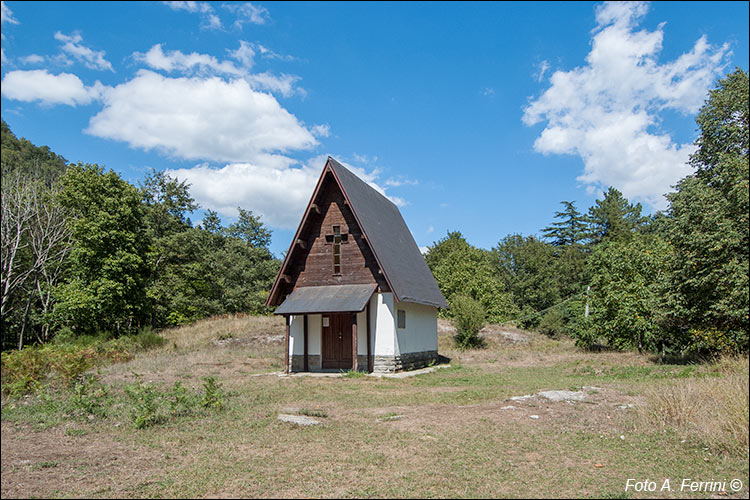DA AIA DI GUERRINO ALLA FORESTA DELLA LAMA
un itinerario nel Parco Nazionale delle Foreste Casentinesi
Italiano
NON SOLO NATURA, ANCHE STORIA
Una piccola chiesa posta su una radura può essere considerata l’inconfondibile simbolo della Lama. Oltre a tanta bella natura da mostrare, la foresta di questo luogo ha una lunga storia da raccontare. Nel XII secolo figurava già dominio dei Guidi. Nel 1380 una parte di questa passò alla Repubblica Fiorentina, stessa sorte toccò all’altra parte nel 1442. In entrambi i casi la foresta fu donata all’Opera di Santa Maria del Fiore che era amministrata dall’Arte della Lana. Il legname da qui ricavato doveva servire alla realizzazione del Duomo di Firenze e veniva anche venduto ai cantieri navali di Pisa e all’Ordine dei Cavalieri di Malta. Anche nel lungo periodo del Granducato di Toscana, La Lama continuò a essere amministrata da Firenze con alti e bassi della sua gestione. Dalla seconda metà del Settecento questa foresta si avviò verso un disastroso degrado, si pensava solo a sfruttare il legname senza curarsi del rimboschimento. Negli anni Trenta dell’Ottocento il Granduca di Toscana Leopoldo II di Lorena più volte si recò personalmente a visitare questa zona dell’appennino rendendosi conto in che disastroso degrado versavano i suoi boschi. Fu così chiamato l’ingegnere forestale boemo Karl Simon (poi naturalizzato Carlo Siemoni) che dal 1838 iniziò le cure a queste montagne. La bellezza naturale che oggi ci offrono sono il frutto della riorganizzazione forestale messa in atto da Siemoni che nel 1846 realizzò nei pressi della Lama una vetreria dove si producevano raffinati bicchieri, bottiglie e altri oggetti. Quest’attività era chiamata Fabbrica dei Cristalli. Oggi non esiste più traccia di questa, ma la zona dove si trovava è ancora chiamata Vetreria. Siemoni realizzò anche una segheria ad acqua e un villaggio in legno per ospitare le molte persone che lavoravano a La Lama in varie occupazioni. Nella seconda metà dell’Ottocento, dopo l’Unità d’Italia, il villaggio andò distrutto da un incendio sicuramente doloso. La storia della ferrovia della Lama è già stata ricordata a pagina 24. È da ricordare che dal 1923 questo luogo, da sempre in terra toscana, passò alla Romagna. Questo per volere di Benito Mussolini che allargò i confini della sua regione affinché il Tevere, il fiume di Roma, nascesse nella sua terra natale. A small church located on a clearing can be considered the unmistakable symbol of the Lama. In addition to so much beautiful nature to show, the forest of this place has a long story to tell. In the XII century it was already the domain of the Guidi. In 1380 part of it passed to the Florentine Republic, the same fate befell the other part in 1442. In both cases the forest was donated to the Opera of Santa Maria del Fiore which was administered by the Arte della Lana. The timber obtained from here was to be used for the construction of the Florence Cathedral and was also sold to the shipyards of Pisa and to the Order of the Knights of Malta. Even in the long period of the Grand Duchy of Tuscany, La Lama continued to be administered by Florence with ups and downs of its management. From the second half of the eighteenth century this forest started towards a disastrous decay, it was thought only to exploit the timber without caring for reforestation. In the 1830s, the Grand Duke of Tuscany Leopoldo II of Lorraine went personally several times to visit this area of the Apennines, realizing the disastrous degradation of its woods. This was the name of the Bohemian forest engineer Karl Simon (later naturalized Carlo Siemoni) who in 1838 began the treatments in these mountains. The natural beauty they offer us today are the result of the forest reorganization implemented by Siemoni who in 1846 built a glass factory near the Lama where refined glasses, bottles and other objects were produced. This activity was called the Crystal Factory. Today there is no longer any trace of this, but the area where it was located is still called Vetreria. Siemoni also built a water sawmill and a wooden village to house the many people who worked in La Lama in various occupations. In the second half of the nineteenth century, after the unification of Italy, the village was destroyed by a fire that was certainly arson. The history of the Lama railway has already been mentioned on page 24. It should be remembered that since 1923 this place, which has always been in Tuscany, passed to Romagna. This was at the behest of Benito Mussolini who expanded the borders of his region so that the Tiber, the river of Rome, was born in his native land.

























































